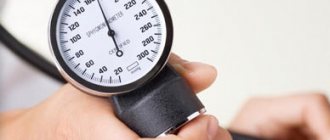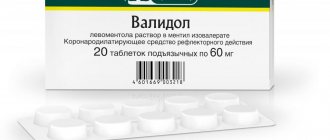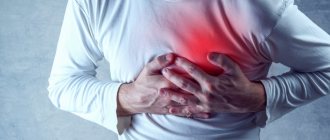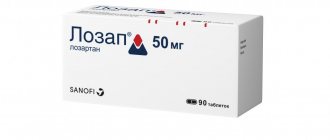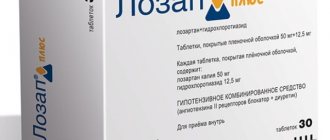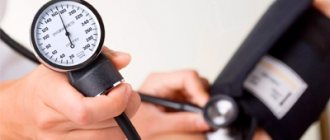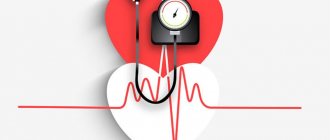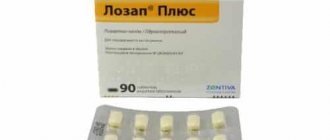Compatibility of Validol and alcohol
? Validol is prescribed for neuroses, diseases of the cardiovascular system, sleep disorders, and stress. They drink it to get rid of anxiety, fears and worries.
Often the purpose of drinking alcohol is to rest, relax, and not think about problems.
The active substance in the medicine is levomenthol solution in menthyl isovalerate. It dilates blood vessels and gives a calming effect.
Ethanol, entering the blood, increases the lumen of blood vessels and reduces the resistance of the vascular walls. Like the main substance, it has a vasodilating effect.
A one-time dose will increase the risk of side effects of the drug, minimize the therapeutic effect and worsen the patient's health.
It is forbidden to drink the drug with ethanol together. It is dangerous to mix medicine with alcohol if the patient has heart disease.
conclusions
So, alcohol and Validol have the opposite effect, so when they are combined, the body experiences additional stress on most systems. When taking pills in the midst of a feast, myocardial vessels may dilate, which will provoke acute cardialgia. Many experts do not recommend combining the drug with alcohol, since the consequences can be unpredictable.
Practice shows that in some patients, when combining these substances, the body became so relaxed that they lost the ability to control bowel movements and urination. No one wants to find themselves in such a situation, so it is better not to take risks and refuse such a combination.
You can take Validol only after alcohol has been removed from the body, and alcohol is allowed only 3-4 hours after taking the medicine.
Any, even the most “harmless” medicine requires a careful and responsible attitude, so before taking it, you must definitely talk to a specialist or at least read the attached instructions. Even herbal preparations may be incompatible with alcohol, so be smart.
Brief characteristics of the drug
“Validol” (Levomenthol) is a sedative in the form of tablets or liquid. Belongs to the group of reflex-vasodilators. The tablet is placed under the tongue, where it quickly dissolves and begins to act within 5 minutes.
The solution is available in ampoules of 5 milliliters. To take it, you need to drop 4-6 drops onto a piece of sugar and place it under your tongue until dissolved.
A drug:
- Reduces pain.
- Improves peripheral blood circulation.
- Relieves nervous tension and relieves spasm of heart vessels.
Indications:
- Pain in the left half of the chest, not associated with damage to the arteries of the heart;
- Disorder of the nervous system without anatomical changes in tissue;
- Attacks of angina, tachycardia
- Rapid heartbeat, irregular heart rhythm;
- State of hysteria;
- Neuroendocrine regulation disorders;
- Toxicosis in pregnant women;
- Hangover syndrome (as an aid).
Contraindications:
- Age under 14 years.
- Chronic alcoholism.
- Intolerance to the components of the drug.
- Low blood pressure in chronic form.
- Diabetes mellitus of the first, second type.
- Acute myocardial infarction.
Side effects:
- Nausea, vomiting, poisoning in case of overdose;
- Tearfulness, increased saliva production;
- A sharp decrease in blood pressure;
- Dizziness, headache;
- A sharp drop in vascular tone;
- Fainting, slow reactions.
Side effects after administration are rare.
Admission rules
Before taking Validol, it is necessary to determine the individual therapeutic susceptibility to the drug.
This will help in determining your personal dosage and the maximum permissible daily amount of the drug. The drug in tablet or capsule form is taken sublingually, in other words, placed under the tongue until completely dissolved. A single dose is considered to be 1 capsule or tablet. You can take Validol no more than 4 times per day, the maximum amount of the drug is 600 mg/day.
If there is a need to take the drug after drinking alcohol, then it is recommended to consider other treatment options, because Validol can be taken only after ethanol has been completely eliminated from the body, i.e. 5-6 hours after the last portion of strong drink. If the pill has already been taken, then alcohol can only be drunk 3-4 hours after the medication.
Use of the drug for alcoholism
Alcoholism is a contraindication to taking the drug. The combination of substances disrupts the functioning of all organs.
There is a dilatation of the blood vessels of the heart with the development of pain.
The body of chronically addicted people is so exhausted that mixing will lead to unexpected consequences:
- Involuntary urination and defecation.
- Complete loss of control and conscious state.
- Severe poisoning.
The drug is metabolized in the liver and excreted by the kidneys in the form of glucuronides. If the exocrine gland is sick and the medicine is mixed with ethyl alcohol, the condition of the liver can worsen to a sharply critical level.
When treating people with alcohol addiction, you need to consult a doctor. He will tell you how long you need to abstain from alcohol before starting treatment, and after how long you can take the drug.
Validol
Validol
Registration number : LP-000612
Trade name : Validol
Group name : Levomenthol solution in menthyl isovalerate&
Dosage form: sublingual tablets.
Compound:
Active ingredient: levomenthol solution in menthyl isovalerate (validol) 0.06 g.
Excipients: sucrose (sugar) – 0.9216 g, calcium stearate monohydrate – 0.0098 g.
Description: flat-cylindrical tablets, beveled and scored, white with a yellowish tint with grayish inclusions, with a characteristic menthol odor
Pharmacotherapeutic group: coronary dilating agent of reflex action.
ATX code : [C01EX]
Pharmacological properties
Pharmachologic effect. It has a sedative effect and has a moderate reflex vasodilator effect due to irritation of sensitive nerve endings. Stimulates the production and release of enkephalins, endorphins and a number of other peptides, histamine, kinins (due to irritation of mucosal receptors), which are actively involved in the regulation of vascular permeability and the formation of pain. When administered sublingually, the therapeutic effect occurs on average within 5 minutes, with up to 70% of the drug released within 3 minutes.
Pharmacokinetics. When administered sublingually, levomenthol is absorbed from the oral mucosa, metabolized in the liver and excreted by the kidneys in the form of glucuronides.
Indications for use
Functional cardialgia, hysteria, neuroses, headache while taking nitra-
Tov, motion sickness syndrome (nausea, vomiting due to sea and air sickness).
Contraindications
Hypersensitivity, sucrase/isomaltase deficiency, fructose intolerance, glucose-galactose malabsorption (since the drug contains sucrose).
Carefully
With diabetes mellitus (the drug contains sugar).
Use during pregnancy and breastfeeding
Prescription of the drug during pregnancy and breastfeeding is possible if the expected benefit to the mother outweighs the potential risk to the fetus and child.
Directions for use and doses
Validol is prescribed to adults, 1 tablet under the tongue until it is completely absorbed. Take 1 tablet 2-3 times a day. The frequency and duration of administration is determined depending on the effectiveness of treatment. If the therapeutic effect is absent or insufficiently expressed, another therapy must be prescribed within the next 5-10 minutes after administration.
Side effect
Nausea, lacrimation, dizziness.
Overdose
Symptoms: headache, nausea, agitation, cardiac dysfunction, sharp decrease in blood pressure, depression of the central nervous system.
Treatment: discontinue the drug. Symptomatic therapy.
Interaction with other drugs
When used together with drugs that depress the central nervous system, it enhances the effect of the latter.
The simultaneous use of Validol with nitrates reduces the headache that occurs when using them.
special instructions
Should be prescribed with caution to patients with diabetes mellitus (for medicines containing sugar).
When taking Validol, you must be careful when driving vehicles and engaging in other potentially hazardous activities that require increased concentration and speed of psychomotor reactions.
Release form
Sublingual tablets 60 mg.
10 tablets in a blister pack made of polyvinyl chloride film and aluminum foil.
2 or 3 blister packs together with instructions for use are placed in a cardboard pack for consumer packaging.
It is allowed to place blister packs with an equal number of instructions for use in a cardboard box (multiple packaging).
Storage conditions:
In a dry place, protected from light, at a temperature not exceeding 25°C.
Best before date:
3 years. Do not use after the expiration date.
Units:
pack
Using the drug for a hangover
It is taken during the post-intoxication period after drinking alcoholic beverages. But hangover medicine doesn't help much.
Action for hangover syndrome:
- Removes unpleasant odors from the mouth;
- Relieves mild headaches;
- Removes attacks of nausea;
- Reduces heart pain;
- Reduces Hell.
It may have unpredictable effects when used during a hangover. Alcohol breakdown products still circulate in the blood, which have a bad effect on internal organs.
Taking the drug can provoke an exacerbation of nervous and cardiovascular diseases.
Consequences of drinking alcohol
The most harmless thing that can happen when mixed with an alcoholic drink is the neutralization of the medicinal effect.
But probably:
- The occurrence of side effects of the drug.
- Severe poisoning of the body, intoxication.
- Dysfunction of internal organs.
The sedative effect of the drug in combination with ethanol will lead to very slow reactions, confusion and fainting. Blood pressure may drop to critical levels.
Symptoms of poisoning appear as:
- Severe vomiting;
- Dizziness;
- Excessive salivation and tearing;
- Swelling, skin rashes;
- Depression of the central nervous system.
Drinking alcohol together with the drug when contraindicated leads to aggravation of existing diseases, kidney and liver failure, and sometimes death.
Is it possible to drink Validol after alcohol?
ALCOHOL AND FAMILY
ALCOHOL AND CAR
ALCOHOL AND THE BODY
ALCOHOL AND MEDICINES
Is it possible to drink Validol after alcohol?
Validol, a well-known sedative, especially effective for emotional breakdowns or heart pain, has become a real “pocket” medicine for many of our citizens. They carry it with them so that, if necessary, they can immediately take a life-saving pill. But many people don’t even think about whether this remedy can be used often, or whether it is allowed to be mixed with other medications.
And some of the especially frivolous citizens, without hesitating for a minute, take Validol against the background of alcohol intoxication. Let's find out whether Validol and alcohol are compatible and how such a combination will affect your well-being. Moreover, taking into account the opinion of doctors who are categorically against this tandem.
A little about the drug
Validol belongs to the group of vasodilators and sedatives. This medication is available in three forms:
- Drip.
- Encapsulated.
- Tableted.
Most often, Validol tablets are used, which are placed under the tongue and dissolve. The active components of the drug irritate the nerve endings located on the mucous membrane. Which ultimately leads to a reflex expansion of the coronary and vascular channels. This stabilizes the patient’s condition.
Validol helps relieve pain syndromes in the heart area, significantly improving peripheral blood supply. The effect of the drug is felt within 3-4 minutes after administration.
Specifics of impact
This medicine has a powerful sedative effect. Thanks to this, the medicine has a wide range of applications. It is successfully used to relieve many pathological conditions associated with heart ailments or nervous tension. Validol, according to its instructions, is used in the following cases:
- neuroses;
- increased hysteria;
- cardiac problems;
- migraines (especially associated with long-term use of nitrates);
- with increased sensitivity of the vestibular apparatus (motion sickness when traveling).
The main components of the product are menthol and isovaleric acid. Many modern experts believe that this medicine, known to us since the times of the Soviet Union, is an ordinary placebo. Of course, such a drug cannot prevent the development of heart attack/stroke. But it is quite possible to relieve palpitations and calm a person with the power of this medicine.
Strong and Validol
As for the situation of combining alcohol and this medication, it is quite common. The point is ethanol’s ability to have a dilating effect on vascular tissue. The intoxicated person feels pleasant euphoria and relaxation, because the blood vessels in the brain areas dilate. True, this reaction does not last long; it is replaced by the opposite - narrowing of the vascular areas and their subsequent spasm, which provokes tachycardia.
Of course, a person accustomed to Validol immediately takes it in the hope of stabilizing the condition, not paying attention to the recent intake of intoxicating drugs. And without even wondering whether it is possible to drink Validol after alcohol. Experimenting with this is strictly prohibited.
The use of Validol against the background of alcohol intoxication is unacceptable. This tandem leads to a sharp deterioration in well-being and has an extremely detrimental effect on the functioning of the heart.
Features of interaction
Before deciding whether to take Validol after alcohol or not, it is worth learning in detail about the compatibility of these two compounds. It is worth knowing that this type of medicine and any kind of intoxicating drink are absolutely incompatible. At best, the consequences of such a tandem will lead to the complete ineffectiveness of the medicine, at worst they will provoke a serious deterioration in health. Many doctors note that Validol and ethanol have a mutually reinforcing effect on the human body.
It is also worth knowing that this cardiac is contraindicated in the following cases:
- severe hypotension (chronic decrease in blood pressure);
- individual intolerance to the components of the drug;
- diabetes mellitus (the medication contains sugar).
What consequences should you expect?
It is worth understanding that any problems in the functioning of the cardiovascular system in themselves become an important prohibiting alcohol factor. Especially in association with Validol. Any medications with vasodilating effects are incompatible with strong drinks. The consequences of such a frivolous attitude towards one's own health can be very unpredictable. In particular:
- Complete neutralization of the action of Validol.
- Slowing down all natural reactions of the body.
- A drop in blood pressure down to critical levels and the development of cardiac muscle collapse.
- A deterioration of a condition that a person is trying to stabilize by using a drug.
- Allergic manifestations. Mainly of a skin nature: urticaria, itchy red rash, swelling, in severe cases Quincke's edema.
- A sharp and vivid manifestation of all the side effects inherent in the drug (nausea, profuse vomiting, dizziness, weakness, semi-consciousness, lacrimation and increased sweating).
Rules for proper use
If Validol is only included in the list of home medicine cabinets, before using it you should make sure that you are susceptible to this medicine. This is done in order to determine the maximum permissible dose of the drug. As a rule, Validol is most often used in tablet or capsule form. Both of these types of medications are taken sublingually. That is, they place the pill under the lingual muscle and leave it there until it is completely absorbed.
On average, one tablet/capsule of the drug is considered a single maximum permissible dose of Validol. The medication can be taken up to 3-4 times per day (no more than 600 mg).
As for the use of intoxicating drinks, relaxation in this way is allowed provided that the body is completely detoxified from the metabolites of the drug (this takes about 4–5 hours). If a person is already in a state of drunkenness, then taking a Validol tablet is allowed no earlier than 6-7 hours after taking the last portion of alcohol.
conclusions
So, Validol and alcohol-containing drinks (in any form and dosage) are completely incompatible substances. The ban on their combination is based on completely opposite effects, which leads to a manifold increase in the load on the cardiovascular and urinary systems. When using Validol in the midst of an alcoholic celebration, against the background of sharply dilating blood vessels, the patient may experience an acute attack of cardialgia.
Medical practice shows that the tandem of Validol and intoxicating alcohol sometimes had such a relaxing effect on the body that a person experienced involuntary acts of defecation and urination. It is unlikely that anyone will want to encounter such an incident, especially when surrounded by people, so it is better to abandon this experiment in advance.
We should not forget that any medication, even the most harmless at first glance, when combined with alcoholic beverages, can turn into a dangerous compound that threatens not only the well-being, but also the life of the patient. Medicines should be handled with extreme caution and awareness. And do not forget to carefully study the attached annotation, especially the paragraph on contraindications, side effects and rules of administration. Don't take your own health lightly.
Reply to post
Replies to post: 1
| Validol, a well-known sedative, especially effective for emotional breakdowns or heart pain, has become a real “pocket” medicine for many of our citizens. They carry it with them so that, if necessary, they can immediately take a life-saving pill. But many people don’t even think about whether this remedy can be used often, or whether it is allowed to be mixed with other medications. |
Olga
14.03.2021
Is it possible to take validol after an extensive party on the second day of sobriety?
Validol and beer
It is strictly forbidden to combine Validol with alcohol to normalize cardiovascular activity.
Consequences of one-time use:
- lack of therapeutic effect;
- slow reactions;
- critical decrease in blood pressure;
- nausea syndrome;
- dizziness;
- excessive salivation and tearing;
- allergic reactions in the form of urticaria, itching, swelling.
You can take the drug only after the breakdown products of alcohol have been completely removed from the body; the form of the drug does not matter. In rare cases it leads to death.
Interaction
When trying to combine any drug with alcohol, you must first familiarize yourself with the compatibility of these substances.
Any drug is accompanied by instructions that describe the possibility or inadmissibility of taking it with alcohol. But is it possible to combine these substances? As for Validol and ethanol, it is strictly forbidden to take these substances at the same time. It’s good if the drug simply doesn’t work; in the worst case, such a combination will further aggravate the patient’s condition.
Some experts note that alcohol and Validol have a mutually reinforcing effect.
In addition to alcohol, Validol is contraindicated for:
- Hypersensitivity to the drug;
- Diabetes. The tablets contain sucrose, which is dangerous for diabetics.
That is why any means of vasodilating action are categorically incompatible. You can drink the drug only after ethanol has been completely eliminated from the body, and the form of the drug does not matter.
In addition, when a person has any problems with the functioning of the cardiovascular system, then alcohol is contraindicated for him in any case, and not just with Validol.
Organs affected by the toxin
The combined use of pharmacological agents and alcohol has a toxic effect on the internal organs and environments of the body. Alcohol, entering into a chemical reaction with a medicine, leads to poisoning, disrupts physiological processes, enhances or weakens the healing properties of drugs.
The liver suffers more than other organs. She gets hit twice. Many medications have a side effect - hepatotoxicity, destroy cells, and disrupt the physiology of the organ. In the liver, alcohol breaks down to ethanal, a substance 20-30 times more toxic than ethanol, which causes the death of hepatocytes.
Dangerous groups of drugs for the organ in combination with alcohol:
- Anti-inflammatory;
- Hormonal;
- Antibacterial;
- Antifungal;
- Glucose control agents for diabetes mellitus;
- Antituberculosis;
- Cytostatics (chemotherapy drugs);
- Tranquilizers (anti-epileptic, psychotropic).
In second place among the internal organs exposed to the harmful effects of alcohol together with medications are the heart and vascular system. Strong drinks during drug therapy constrict blood vessels and increase blood pressure. The simultaneous intake of alcohol and chemical substances leads to failure of the myocardium and increases the risk of developing an attack of angina pectoris and a heart attack.
A mixture of ethanol and pharmaceuticals disrupts the quality of the blood and reduces clotting. This is dangerous due to internal bleeding and strokes.
The effect of Corvalol on the human body
Corvalol is a broad-spectrum drug. The product is actively used in medicine and finds its place in the home medicine cabinet of almost every family. The effectiveness of Corvalol is explained by the components included in its composition. The combination of valeric acid ester and ethyl has a sedative effect, sodium phenobarbital helps to calm the nervous system and also has a vasodilator property, peppermint oil demonstrates antispasmodic and anti-inflammatory effects.
The effect of the medication on the body depends on the dose taken by the patient. For example, as a treatment for heart problems, doctors consider 15 to 30 drops of medication sufficient for adults. For children, the recommended dosage should be reduced to 15 drops.
Rules for taking medications and alcohol
Drinking alcohol during treatment minimizes the clinical effect of therapy and creates a risk of developing complications of the disease.
If this cannot be avoided, follow the rules of behavior that will reduce the consequences:
- Do not drink strong drinks (vodka, cognac, whiskey), choose dry wine (100-150 ml), beer (no more than 300 ml). Don't drink alcohol on an empty stomach.
- The interval between taking the medicine and alcohol should be at least 2 hours.
- To reduce the toxic effect, take medications that protect the liver (hepatoprotectors), pancreas (pancreatin), and stomach (antacids ─ Rennie, Almagel).
If a person takes antiviral medications for colds, anti-inflammatory drugs, alcohol in moderation does not pose a threat to the body.
Alcoholic drinks during treatment are contraindicated in cases of liver cirrhosis, severe infectious diseases, and during a course of chemotherapy.
Medicines, alcohol and chronic diseases
If a person has chronic diseases, simultaneous use of alcohol and medications is potentially dangerous for the functioning of vital organs. Since patients systematically take prescribed medications, the influence of alcohol can lead to negative consequences.
People with chronic heart disease (angina pectoris, heart defects) develop arrhythmias of varying severity. Heart attacks with severe pain syndrome develop, which is not relieved by Nitroglycerin, and the risk of developing myocardial infarction increases significantly.
In case of chronic liver diseases (viral hepatitis, hepatosis), alcohol during treatment will become a trigger in the development of cirrhosis and hepatocellular carcinoma (cancer).
Drinking alcohol during cirrhosis leads to the following consequences:
- Bleeding into the abdominal cavity;
- Liver decomposition, infection, peritonitis;
- Hepatic coma;
- Death.
If a person is on long-term treatment with sedatives, psychotropic drugs, tranquilizers, he is contraindicated in drinking alcohol. This leads to severe depression and the appearance of obsessive states (hallucinations, phobias). Suicidal feelings develop. The patient needs constant monitoring and assistance from a psychiatrist.
The most dangerous combinations and consequences
The combination of alcohol and chemical-based drugs leads to serious disorders in the body, and sometimes to fatal consequences.
List of medications and their side effects in combination with alcohol:
| Name of group, drug | Negative results of interaction |
| Neuroleptics (tranquilizers, anticonvulsants, hypnotics) | Severe intoxication, up to cerebral coma |
| CNS stimulants (Theophedrine, Ephedrine, Caffeine) | Rapid increase in blood pressure, hypertensive crisis |
| Antihypertensives (Captofrin, Enalapril, Enap-N), diuretics (Indapamide, Furosemide) | Sudden drop in pressure, collapse |
| Analgesics, anti-inflammatory | Increased toxic substances in the blood, general poisoning of the body |
| Acetylsalicylic acid (Aspirin) | Acute gastritis, perforation of gastric ulcer and 12-PC |
| Paracetamol | Toxic liver damage |
| Hypoglycemic (Glibenclamide, Glipizide, Metformin, Phenformin), insulin | A sharp decrease in blood sugar levels, hypoglycemic coma |
